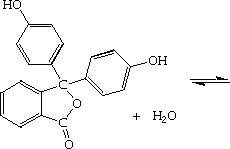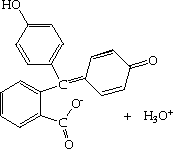
Consider an indicator which is a weak acid, with the formula HIn. At equilibrium, the following equilibrium equation is established with its conjugate base:

The acid and its conjugate base have different colours. At low pH values the concentration of H3O+ is high and so the equilibrium position lies to the left. The equilibrium solution has the colour A. At high pH values, the concentration of H3O+ is low - the equilibrium position thus lies to the right and the equilibrium solution has colour B.
Phenolphthalein is an example of an indicator which establishes this type of equilibrium in aqueous solution:
 |  |
| colourless (Acid) | pink (Base) |
Phenolphthalein is a colourless, weak acid which dissociates in water forming pink anions. Under acidic conditions, the equilibrium is to the left,and the concentration of the anions is too low for the pink colour to be observed. However, under alkaline conditions, the equilibrium is to the right, and the concentration of the anion becomes sufficient for the pink colour to be observed.
We can apply equilibrium law to indicator equilibria - in general for a weak acid indicator:

Kln is known as the indicator dissociation constant. The colour of the indicator turns from colour A to colour B or vice versa at its turning point. At this point:

So from equation:

The pH of the solution at its turning point is called the pKln and is the pH at which half of the indicator is in its acid form and the other half in the form of its conjugate base.
| Indicator | Colour | pKln | pH range | |||
| Acid | Base | |||||
| Thymol Blue - 1st change | red | yellow | 1.5 | 1.2 - 2.8 | ||
| Methyl Orange | red | yellow | 3.7 | 3.2 - 4.4 | ||
| Bromocresol Green | yellow | blue | 4.7 | 3.8 - 5.4 | ||
| Methyl Red | yellow | red | 5.1 | 4.8 - 6.0 | ||
| Bromothymol Blue | yellow | blue | 7.0 | 6.0 - 7.6 | ||
| Phenol Red | yellow | red | 7.9 | 6.8 - 8.4 | ||
| Thymol Blue - 2nd change | yellow | blue | 8.9 | 8.0 - 9.6 | ||
| Phenolphthalein | colourless | pink | 9.4 | 8.2 - 10.0 |
A Universal Indicator is a mixture of indicators which give a gradual change in colour over a wide pH range - the pH of a solution can be approximately identified when a few drops of universal indicator are mixed with the solution.
Indicators are used in titration solutions to signal the completion of the acid-base reaction.